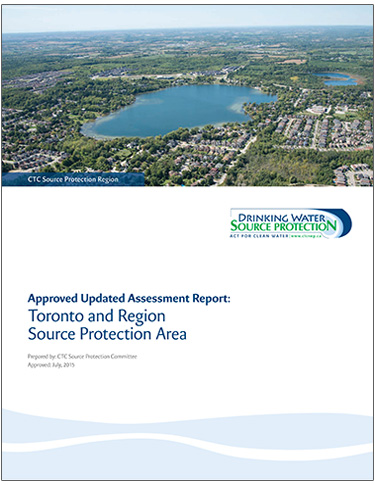This report describes the physical features and water resources within the Toronto and Region Source Protection Area jurisdiction. Using approved provincial methodologies, it delineates vulnerable areas, and assesses specific activities that pose potential drinking water threats within these vulnerable areas.
Where drinking water threats have been identified as significant, the Source Protection Plan outlines what policies apply.
Note to readers: The Assessment Report documents linked below are the amendments to the Toronto and Region Source Protection Area Assessment Report approved on February 23, 2022 and that came into effect March 2, 2022. Following June/July 2023 public consultation, the most recent amendments to the Toronto and Region Source Protection Area Assessment Report were approved on February 29, 2024 and came into effect on March 6, 2024. The 2024 amended Assessment Report will be posted here in the near future. Please contact us with any interim questions regarding the recently approved amendments.
Download the Report by Chapter
- Cover, Preface, Executive Summary and Glossary
- Chapter 1 provides a brief overview of the provincial context for source water protection, previous work done on this issue, and the goals of the source water protection planning process.
- Chapter 2 describes the physical and human characteristics of the Toronto and Region Source Protection Area jurisdiction, including its physiography, geology, hydrology, terrestrial and aquatic ecology, human characterization, water quality, and water uses.
- Chapter 3 summarizes the water budget and water quantity stress assessment.
- Chapter 4 identifies the vulnerable areas required as part of the source protection program within the study area.
- Chapter 5 describes how drinking water threats and issues were identified and lists threats within Toronto and Region Source Protection Area’s jurisdiction.
- Chapter 6 summarizes the Assessment Report contents and next steps.
- Chapter 7 provides a list of references, which includes a number of technical reports prepared by consultants.
Appendices
- Appendix A provides a description of the Data Sources.
- Appendix B provides additional information for Chapter 2 on the Watershed Characterization data gaps and supplementary water quality data.
- Appendix C documents the methodologies employed in the development of understanding the water supply and demand across the Toronto and Region Source Protection Area.
- Appendix D provides additional documentation of the Vulnerable Areas assessment process including the MOE Technical Bulletins on vulnerability.
- Appendix E includes the MOE Technical Bulletin for the threat assessment process as well as output from the South Georgian Bay Lake Simcoe conformance exercise on the enumeration of threats, summaries of the municipal threat assessment reports prepared for municipalities and a summary of the work completed for the Lake Ontario Collaborative for the assessment of threats to Lake Ontario drinking water intakes.
Significant Threats
The Lake Ontario modelling identified 19 locations of significant drinking water quality threats related to Lake Ontario intakes within the Toronto and Region Source Protection Area. In addition, 10 significant drinking water quality threats from activities within the Toronto and Region Source Protection Area have been identified affecting five Lake Ontario intakes outside the Toronto and Region Source Protection Area.
With respect to groundwater, 462 significant drinking water quality threats have been identified in this Assessment Report. No existing water quantity threats have been identified for the WHPA Q1/Q2 in York/Durham. No drinking water quality issues were identified in WHPAs of municipal wells within the Toronto and Region Source Protection Area.

